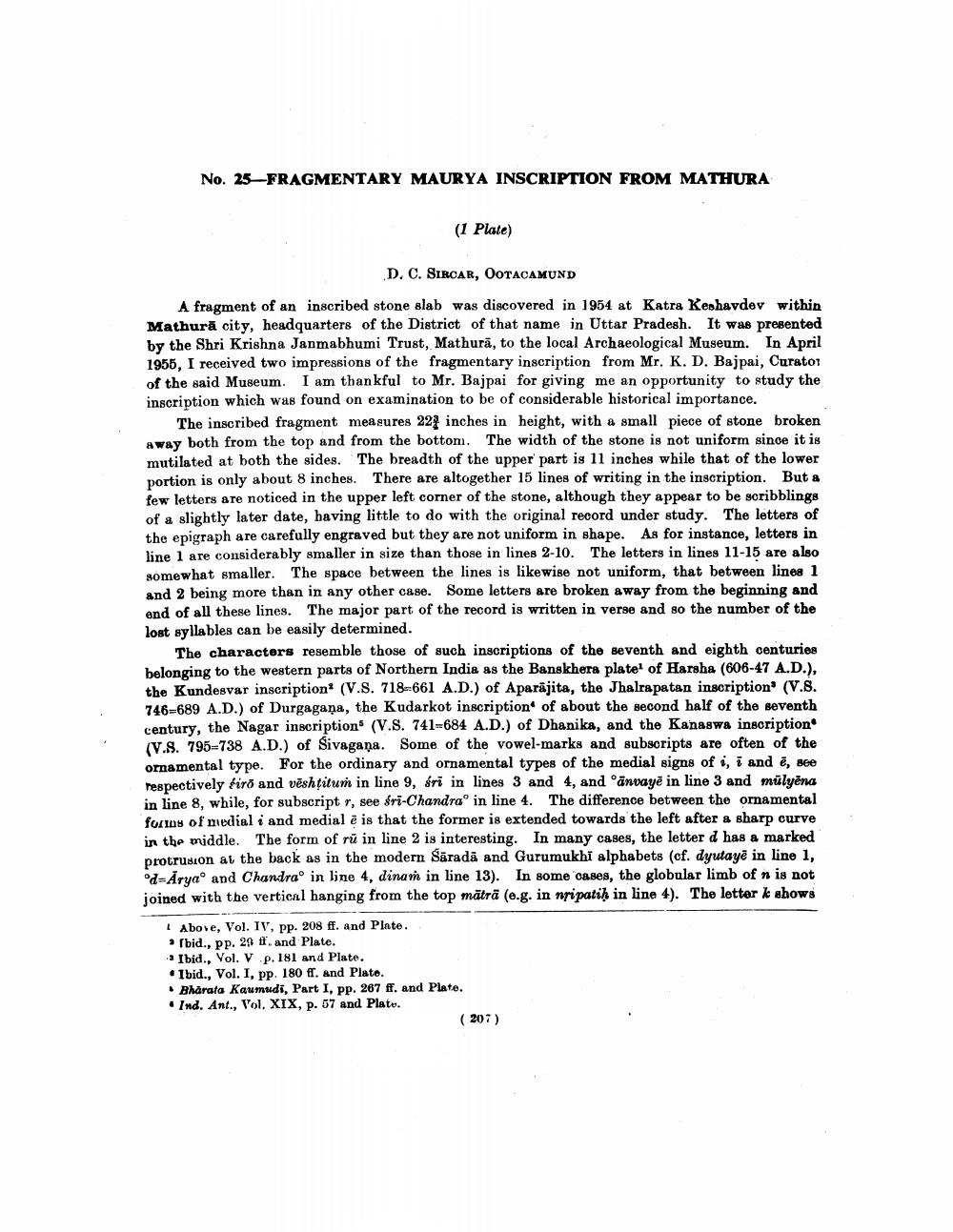________________
No. 25-FRAGMENTARY MAURYA INSCRIPTION FROM MATHURA
(1 Plate)
D. C. SIRCAR, OOTACAMUND
A fragment of an inscribed stone slab was discovered in 1954 at Katra Keshavdev within Mathura city, headquarters of the District of that name in Uttar Pradesh. It was presented by the Shri Krishna Janmabhumi Trust, Mathura, to the local Archaeological Museum. In April 1955, I received two impressions of the fragmentary inscription from Mr. K. D. Bajpai, Curator of the said Museum. I am thankful to Mr. Bajpai for giving me an opportunity to study the inscription which was found on examination to be of considerable historical importance.
The inscribed fragment measures 22 inches in height, with a small piece of stone broken away both from the top and from the bottom. The width of the stone is not uniform since it is mutilated at both the sides. The breadth of the upper part is 11 inches while that of the lower portion is only about 8 inches. There are altogether 15 lines of writing in the inscription. But a few letters are noticed in the upper left corner of the stone, although they appear to be scribblings of a slightly later date, having little to do with the original record under study. The letters of the epigraph are carefully engraved but they are not uniform in shape. As for instance, letters in line 1 are considerably smaller in size than those in lines 2-10. The letters in lines 11-15 are also somewhat smaller. The space between the lines is likewise not uniform, that between lines 1 and 2 being more than in any other case. Some letters are broken away from the beginning and end of all these lines. The major part of the record is written in verse and so the number of the lost syllables can be easily determined.
The characters resemble those of such inscriptions of the seventh and eighth centuries belonging to the western parts of Northern India as the Banskhera plate' of Harsha (606-47 A.D.), the Kundesvar inscription (V.S. 718-661 A.D.) of Aparajita, the Jhalrapatan inscription (V.S. 746-689 A.D.) of Durgagana, the Kudarkot inscription of about the second half of the seventh century, the Nagar inscriptions (V.S. 741-684 A.D.) of Dhanika, and the Kanaswa inscription (V.S. 795-738 A.D.) of Sivagana. Some of the vowel-marks and subscripts are often of the ornamental type. For the ordinary and ornamental types of the medial signs of i, i and è, see respectively firo and veshtitum in line 9, śri in lines 3 and 4, and anvaye in line 3 and mulyēna in line 8, while, for subscript r, see śri-Chandra in line 4. The difference between the ornamental forms of medial i and medial è is that the former is extended towards the left after a sharp curve in the middle. The form of ru in line 2 is interesting. In many cases, the letter d has a marked protrusion at the back as in the modern Sarada and Gurumukhi alphabets (cf. dyutaye in line 1, d-Arya and Chandra in line 4, dinam in line 13). In some cases, the globular limb of n is not joined with the vertical hanging from the top maträ (e.g. in nripatiḥ in line 4). The letter k shows
Above, Vol. IV, pp. 208 ff. and Plate.
fbid., pp. 20 ft. and Plate.
Ibid., Vol. V p. 181 and Plate.
Ibid., Vol. I, pp. 180 ff. and Plate.
Bharata Kaumudi, Part I, pp. 267 ff. and Plate.
Ind. Ant., Vol. XIX, p. 57 and Plate.
(207)




